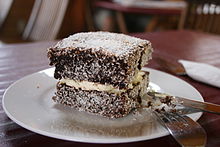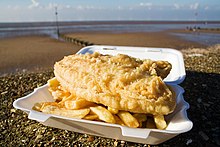New Zealand cuisine
The New Zealand cuisine is based on two traditions: European cuisine and food culture of the indigenous Maori .
History and Development of New Zealand Cuisine
The former European settlers in New Zealand brought animals, plants, food and their food culture from their home countries and tried to introduce English and Scottish cuisine into New Zealand . Meat in general and mutton in particular were their staple foods. The shoemaker George Catley stated: “This is the place for beef steaks and mutton… What with one good thing and another I am getting quite stout, and have every reason to like this country.” (German: Here is the place for Beef and Mutton. With all this good food I get quite stout and I like this country for good reason). As Lady Barker reported in 1883, wealthy settlers ate “ porridge with new milk and cream a discretion” for breakfast .

At the same time, the Māori used numerous edible berries, juices, pulp and pollen grains in their kitchen. They traditionally ate root vegetables like kumara ( sweet potato ), taro and yams and lots of seafood because New Zealand has little fauna . The first missionaries tried to adapt the Maori to European food , but only with varying success. The Māori have preserved special celebrations that are closely related to their traditional food culture.
The cuisine of the Pākehā (non-Māori or non-Polynesians) from the 19th century to the middle of the 20th century reflected the fascination for new ovens. In 1951, the Scot Eric Linklater reported that New Zealanders were very interested in pastries and baked goods of all kinds. “Ladies, please bring a plate!” Was (and is today without “women”) a typical New Zealand idiom that means that women going to an event should take a plate full of baked goods with them. Lamington's biscuits were and are particularly popular.
From the 1960s onwards, New Zealand cuisine became more varied and international. While there were few restaurants to be found in New Zealand in the past, their number has grown faster and faster. There were not only traditional and ethnic restaurants, but also American and Australian fast food restaurants such as Kentucky Fried Chicken (opened 1970/71 in Auckland), Pizza Hut (1975), Homestead (1975), and McDonald’s (1979).
Auckland's restaurants from 1961 to 1986
| year | NL | L. | E. | total |
|---|---|---|---|---|
| 1961 | 92 | - | 2 | 94 |
| 1965 | 125 | 15th | 7th | 140 |
| 1970-71 | 151 | 18th | 14th | 169 |
| 1975 | 160 | 57 | 38 | 217 |
| 1980-81 | 247 | 129 | 78 | 377 |
| 1986 | 168 | 203 | 113 | 560 |
NL: unlicensed; L: licensed; E: ethnic
Local specialties
Hāngi
Hāngi , a kind of earth oven, is a traditional Maori cooking technique used to cook meat, poultry, vegetables and desserts.
Today hāngi is offered as an industrial ready-to-eat and frozen meal as well as a fast food outside of New Zealand.
meat and fish
Some of New Zealand's most signature dishes are roast lamb, bluff oysters, and fish and chips . Roast lamb is popular in New Zealand as a traditional sunday roast . This tradition comes from British immigrants. Roast lamb is usually served with fried potatoes, kumara (sweet potatoes) and pumpkin, as well as green peas, and with gravy or mint sauce.
Bluff oysters are a New Zealand delicacy. They are considered to be the meatiest and juiciest oysters in the world. They can only be eaten from March to August and come exclusively from Bluff , home port of the Foveaux Strait oyster fleet.
Fish and Chips (deep-fried fish fillet in beer batter with French fries) isNew Zealand'smost popular fast food dish, comparable to the popularity of schnitzel with French fries in Germany. The type of fish is usually Tarakihi , Hoki , Cod, or Snapper , depending on the location of the store.
Pies
Typical New Zealand specialties include a variety of pies such as meat pie ( meat pie ), minced pie and sausage roll (sausage wrapped in puff pastry). The typical New Zealand pate is filled with beef , lamb , fish or vegetables. On average, each New Zealander consumes 15 meat pies a year.
sandwich
Different sandwiches are eaten in New Zealand.
There are not only traditional sandwiches with ham, sausages, cheese and lettuce, but also wraps . Their filling is often a mixture of European and Asian ingredients and spices.
Salads
There are mixed vegetable salads made from fresh or grilled vegetables, rice salad , fish salad and pasta salad in European style. Asian ingredients and spices such as rice noodles , tofu , pak choi , ginger , curry powder , wasabi and Thai chilli sauce are also used in salads.
dessert
The most famous dessert recipe in New Zealand is Pavlova , a meringue cake filled with cream and fruit , which is decorated with kiwi fruit, strawberries and passion fruits . Pavlova is also claimed as a national dish by Australia.
Many of the traditional New Zealand confectioneries can be found in popular cookbooks such as Edmonds Cookery Book . Two examples of homemade sweets are:
- ANZAC biscuits , cookies made from oatmeal, syrup, butter, sugar, flour, baking powder and coconut. The cookies were named after the New Zealand and Australian soldiers in World War I because they were often sent to them. Anzac biscuits do not contain eggs, so they have a long shelf life. For this reason they were suitable for being transported far.
- Pikelets, a New Zealand pancake recipe , which is also found in Australia and Scotland. Pikelets consist of a batter, similar to the batter, but are baked thicker and smaller.
- Hokey Pokey is a New Zealand type of toffee made from sugar, water, syrup, and baking soda. The consistency of Hokey Pokey looks hard, but it is holey and soft on the inside, like a sponge. When the baking powder reacts to the other ingredients and to the heat, the toffee gets this consistency.
literature
- Ray Bailey, Mary Earle: Home Cooking. Changes in Food Consumption in New Zealand during 1880–1990. Massey University - Deptepartment of Food Technology, Palmerston North NZ 1993, ISBN 0-908665-85-7 .
- Patricia Bawden: Food and Culture in New Zealand. New House Publishers, Auckland NZ 1999, ISBN 1-86946-839-2 .
- Ian Brailsford: If there's not one near you now, there soon will be: American Fast-food Chains Chains Come to New Zealand. In: The New Zealand Journal of History. 39, 1, 2005, ISSN 0028-8322 , pp. 57-62.
- David Burton: New Zealand Food and How to Cook It. David Bateman Ltd, Auckland NZ 1991, ISBN 1-86953-066-7 .
- Kate Fraser: Cooking Time. What Makes Kiwi Cuisine Unique. HarperCollins, Auckland NZ 2008, ISBN 978-1-86950-658-2 .
- Tony Simpson: A Distant Feast. The Origins of New Zealand's Cuisine. Godwit, Auckland NZ 1999, ISBN 1-86962-037-2 .
Web links
- New Zealand History online (English)
Individual evidence
- ^ A b Tony Simpson, A Distant Feast. The Origins of New Zealand's Cuisine. P. 73.
- ↑ Eric Linklater : A Year of Space. A Chapter in Autobiography. Macmillan, London, 1953.
- ↑ Ray Bailey, Mary Earle: Homecooking to Takeaways. P. 262.
- ↑ http://www.maorifood.com/hangi.htm
- ↑ http://www.newzealandatoz.com/index.php?pageid=174&Hangi
- ↑ Indigenous Hangi Cuisine - "A Taste of Maori Tradition" . Puff'n Billy Foods Ltd , 2002, archived from the original on October 14, 2008 ; accessed on May 1, 2019 (English, original website no longer available).
- ↑ The Hot Earth Hangis franchise brings the Hangi fast food of yore . Franchise Council of Australia , December 29, 2007, archived from the original on August 8, 2008 ; accessed on January 13, 2016 (English, original website no longer available).
- ^ Roasting - The classic way to cook New Zealand Lamb . Meat & Wool New Zealand , 2004, archived from the original on April 26, 2006 ; accessed on August 30, 2014 (English, original website no longer available).
- ↑ Aquaculture species: Bluff Oysters . NIWA Science - National Center for Fisheries & Aquaculture , 2007, archived from the original on March 8, 2008 ; accessed on August 30, 2014 (English, original website no longer available).
- ↑ Helen May Leach: The Pavlova Story: A Slice of New Zealand's Culinary History . Otago University Press, 2008.
- ↑ http://www.anzacbiscuit.net/




